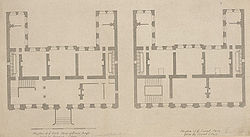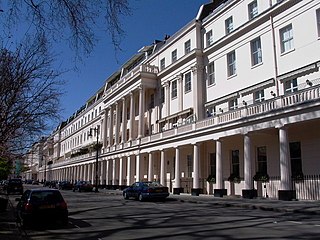
Mayfair is an affluent area in the West End of London towards the eastern edge of Hyde Park, in the City of Westminster, between Oxford Street, Regent Street, Piccadilly and Park Lane. It is one of the most expensive districts in the world.
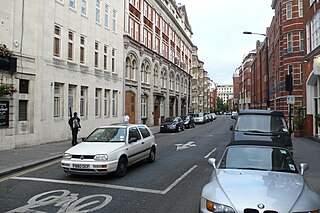
Drury Lane is a street on the eastern boundary of the Covent Garden area of London, running between Aldwych and High Holborn. The northern part is in the borough of Camden and the southern part in the City of Westminster. Drury Lane is part of London's West End Theatreland.

Belgravia is a district in Central London, covering parts of the areas of the City of Westminster and the Royal Borough of Kensington and Chelsea.

A mansion is a large dwelling house. The word itself derives through Old French from the Latin word mansio "dwelling", an abstract noun derived from the verb manere "to dwell". The English word manse originally defined a property large enough for the parish priest to maintain himself, but a mansion is no longer self-sustaining in this way. Manor comes from the same root—territorial holdings granted to a lord who would "remain" there.


Powis Castle is a medieval castle, fortress and grand country house near Welshpool, in Powys, Wales. The seat of the Herbert family, earls of Powis, the castle is known for its formal gardens and for its interiors, the former having been described as "the most important", and the latter "the most magnificent", in the country. The castle and gardens are under the care of the National Trust. Powis Castle is a Grade I listed building, while its gardens have their own Grade I listing on the Cadw/ICOMOS Register of Parks and Gardens of Special Historic Interest in Wales.

Belgrave Square is a large 19th-century garden square in London. It is the centrepiece of Belgravia, and its architecture resembles the original scheme of property contractor Thomas Cubitt who engaged George Basevi for all of the terraces for the 2nd Earl Grosvenor, later the 1st Marquess of Westminster, in the 1820s. Most of the houses were occupied by 1840. The square takes its name from one of the Duke of Westminster's subsidiary titles, Viscount Belgrave. The village and former manor house of Belgrave, Cheshire, were among the rural landholdings associated with the main home and gardens of the senior branch of the family, Eaton Hall. Today, many embassies occupy buildings on all four sides.

Montagu House was a late 17th-century mansion in Great Russell Street in the Bloomsbury district of London, which became the first home of the British Museum. The first house on the site was destroyed by fire in 1686. The rebuilt house was sold to the British Museum in 1759, and demolished in the 1840s to make way for the present larger building.

Queen Square is a garden square in the Bloomsbury district of central London. Many of its buildings are associated with medicine, particularly neurology.

Newcastle House is a mansion in Lincoln's Inn Fields in central London, England. It was one of the two largest houses built in London's largest square during its development in the 17th century, the other being Lindsey House. It is the northernmost house on the western side of the square.
There are several long-established Nordic churches in London. All seek to provide Lutheran Christian worship and pastoral care to their respective national communities in their own languages. Many of the churches also organise language classes and organise a wide range of social activities.

Bryanston Square is an 800-by-200-foot garden square in Marylebone, London. Terraced buildings surround it — often merged, converted or sub-divided, some of which remain residential. The southern end has the William Pitt Byrne memorial fountain. Next to both ends are cycle parking spaces.

St Mary Magdalene Woolwich is an 18th-century Anglican church dedicated to St Mary Magdalene in Woolwich, southeast London, England.

Marylebone is a district in the West End of London, in the City of Westminster. Oxford Street, Europe's busiest shopping street, forms its southern boundary.
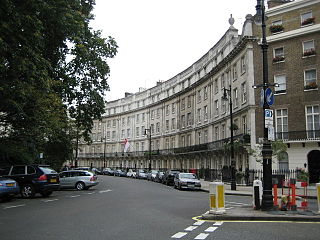
Wilton Crescent is a street in central London, comprising a sweeping elegant terrace of Georgian houses and the private communal gardens that the semi-circle looks out upon. The houses were built in the early 19th century and are now Grade II listed buildings. The street is the northern projection of Belgravia and is often taken to fall into the category of London's garden squares.
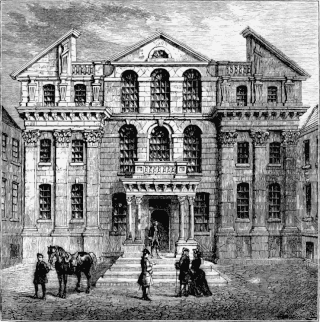
Monmouth House was a 17th-century mansion in Soho Square built for the Duke of Monmouth, the oldest illegitimate son of King Charles II. After the Duke's execution for attempting to lead a rebellion against the unpopular Catholic successor to Charles, James II, the house was owned by the Bateman family and loaned to various important people including the French ambassador before being demolished in 1773.

The Perseverance is a pub at 63 Lamb's Conduit Street, Bloomsbury, London WC1, on the corner with Great Ormond Street.

South Audley Street is a major shopping street in Mayfair, London. It runs north to south from the southwest corner of Grosvenor Square to Curzon Street.

Powis Street is a partly pedestrianised shopping street in Woolwich in the Royal Borough of Greenwich, south-east London, England. It was laid out in the late 18th century and was named after the Powis brothers, who developed most of the land in this part of the town. The street has been rebuilt several times but has retained some notable examples of late-Victorian and Art Deco architecture. Since 2019 the street is part of a conservation area.

